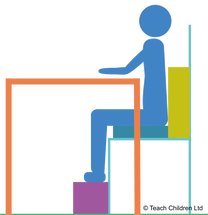Sitting & Paper - FAQs

The main aim is to be able to push the chair under the table so that when your child is sitting correctly they are; close to the table but not touching it with their tummy. Their elbows should rest comfortably on the table while leaning slightly forward to form a triangle position which encourages them to use the supporting hand (non-writing hand) to move the paper up the table when writing.
- If the table height is too high for your child try using a booster seat or cushions to raise them up so that their bent elbow is about 5 cm above the table.
- If the table height is too low you could use blocks or bricks to raise the table to a more suitable height (making sure that the table is secure and cannot slip off the blocks).
- If a chair is too high for your child try using a plastic box or step for them to rest their feet on.
- If the chair is too deep for your child when they sit right back in it, try propping cushions up behind them, some children may not find this comfortable so just do the best you can with the furniture you have.
By positioning and tilting the paper correctly your child's writing hand stays in one comfortable position on the table. Their non-writing hand moves the paper diagonally up the table (while maintaining an appropriate paper tilt angle).
With the non-writing hand moving the paper up the table the writing line stays in the same place which means eye movements are less, helping to make the writing experience less tiring and stressful.
If the paper is positioned and tilted correctly, with their writing hand under the writing line, they will also be able to see more easily what they have just written and where to place the next letter, word or section of text on the page. This is especially important for left-handed writers.
Young children, due to the stage of their physical development, draw from the shoulder rather than the elbow and wrist using large arm movements. At this stage they often prefer vertical drawing and painting surfaces as it allows a free range of movements. This is often why young children will write on walls, not because they are being naughty but because it just feels comfortable and so more enjoyable.
Drawing and writing on a vertical surface is important at this stage as it helps young children develop the wrist strength and flexibility they will need later on to hold a pencil correctly for handwriting.
The jump from a vertical to a horizontal writing surface can seem too great for some children; due to their stage of development. These children may benefit from the paper being positioned on a sloped board.
If you are not sure whether your child needs a sloped board for handwriting, instead of buying a specialist board, you could make one. Try using a ring binder or lever arch file stuffed with magazines and newspaper to make a sloped board. Tape the edges to stop the papers falling out; you could cover it in sticky back plastic to give a smoother finish to the board. The advantage of this is that you can make them to any angle of slope. Try a few to see which, if any, your child prefers.
A homemade sloped board is just as effective as a bought one. Often a child only requires one for a short amount of time and quickly moves to writing on a horizontal surface. For a few children a sloped surface may be required for a few years, or indefinitely, in which case a purpose bought sloped writing board is a sounder investment.
Some children don’t have the strength to sit correctly at a table or on the floor. Typical signs would be that they lie with their head on the table, use a hand to support their head, wedge themselves between the table and chair or lie across the floor. This is most probably a sign of poor posture base strength.
For your child to sit comfortably, and for an extended period of time, the table and chair need to be the correct size for them.
To position and move the paper correctly up the table, to make handwriting more comfortable, a child needs good bilateral coordination skills. Games and activities can be used to develop this strength.

